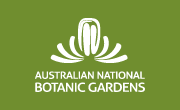Census of the Vascular Plants,
Hornworts, Liverworts and Slime Moulds
of the Australian Capital Territory
Version 3.0
(ARCHIVE: see latest version for current information)
8th June 2012
B.J. Lepschi, D.J. Mallinson and D.C.Cargill (editors)
Contributors
L.G.Adams, B.J.Lepschi, D.J.Mallinson (vascular plants excluding Orchidaceae)
D.C.Cargill (hornworts and liverworts)
H.Lepp (slime moulds)
M.A.Clements and D.L.Jones (Orchidaceae)
S.B.Sharp (common names)
(Note: vascular plant web pages below are large, ~670 KB)
Introduction
This Census lists the scientific names of the native and naturalised vascular plants (Pinophyta and Magnoliophyta), hornworts (Anthocerophyta), liverworts (Marchantiophyta) and slime moulds (Myxogastria) known to occur in the Australian Capital Territory, but excluding the Australian Commonwealth Territory of Jervis Bay on the New South Wales south coast. All records are based on herbarium specimens housed in the Australian National Herbarium (CANB). This version of the Census updates version 2.0 (12th December 2008). Future versions of the Census will provide additional coverage of remaining cryptogamic groups including mosses, lichens, algae and fungi.
As with all censuses, this is a work in progress, and changes to the taxa listed can be expected as new collections and data become available. The Census compilers welcome any feedback – please contact us at canbr-info@anbg.gov.au if you have any comments or corrections.
Census of Vascular Plants of the ACT (alphabetical by family)
Census of Vascular Plants of the ACT (alphabetical by genus)
Census of Hornworts & Liverworts of the ACT (alphabetical by family)
Census of Hornworts & Liverworts of the ACT (alphabetical by genus)
Census of Slime Moulds of the ACT
Statistics for the ACT flora
Explanatory text for Census fields
Family
Family concepts for all groups except slime moulds follow those adopted by the Australian Plant Census (see www.anbg.gov.au/chah/apc), with some modifications (e.g. Caesalpiniaceae and Mimosaceae are retained as distinct families rather than being included in an expanded Fabaceae). Slime mould families follow Kirk et al. (2008).
Plant name
Taxonomic concepts are those adopted by the Australian National Herbarium. For all groups except slime moulds these generally follow those recommended by the Australian Plant Census where relevant groups have been treated, but may diverge where a differing view is held by research staff at CANB.
Taxa that have not yet been formally published are listed using the format recommended by the Council of Heads of Australasian Herbaria (CHAH) for informal names, as outlined by Barker (2005).
Authors of plant names and supplementary nomenclatural information are available for vascular plants, hornworts and liverworts by clicking on individual plant names, which are directly linked to the Australian Plant Name Index (APNI – see www.anbg.gov.au/apni/index.html ).
Origin
This field indicates whether a taxon is indigenous to Australia and/or the ACT.
• Blank – indigenous Australian taxon occurring naturally in the ACT
• Exotic [EA] – a taxon introduced to Australia and the ACT (i.e. extra-Australian)
• Exotic [Aust] – an indigenous Australian taxon which does not occur naturally in the ACT. This applies to many native Australian plants which have become naturalised outside their normal ranges (e.g. Acacia baileyana, Melaleuca armillaris subsp. armillaris)
• Indigenous/Exotic [Aust] – an indigenous Australian taxon, represented in the ACT by both naturally occurring and naturalised populations. For example, Passiflora cinnabarina, restricted naturally in the ACT to the Booroomba Rocks area, but also occurring as naturalised plants on Black Mountain, originating from plantings within the Australian National Botanic Gardens
Uncertain – a taxon of indeterminate status in the ACT. Three taxa are treated under this definition in the current version of this census: Maireana microphylla, Oxalis thompsoniae and Salsola australis. It is unclear whether plants of Maireana microphylla occurring in the ACT are naturally occurring, or introductions from outside the ACT. The status of Oxalis thompsoniae in Australia is unclear, and it may represent an indigenous taxon or an introduction (see Conn & Richards 1994).
Considerable confusion surrounds the taxonomy and status of Salsola in Australia (see Australian Plant Census (www.anbg.gov.au/chah/apc), and plants of Salsola australis naturalised in the ACT may represent either an indigenous or extra-Australian taxon.For the purposes of this census, the definition of a naturalised plant is a plant originating outside of the Australian Capital Territory, subsequently introduced to the ACT by or with the help of human intervention, and persisting there unaided by human intervention.
Naturalised Status
This field is blank for taxa occurring naturally in the ACT.
Non-indigenous plants display varying degrees of persistence and naturalisation in the ACT (and indeed Australia). Some, like Echium plantagineum or Hypochoeris radicata, are common and widespread, with large, widely distributed, self-sustaining populations. Others, like Mirabilis jalapa or Solanum lycopersicon are more ephemeral, with scattered small populations which may or may not persist in the longer term. Taxa in the latter category are treated as Doubtfully Naturalised, indicating that the taxon is known to occur in the ACT and is represented by one or more populations, but the extent of naturalisation is uncertain. These taxa have the potential to become ‘truly’ naturalised.
Non-indigenous taxa previously recorded from the ACT, but for which no collections have been made within the past 30 years, are treated as Formerly Naturalised. Similarly, non-indigenous taxa previously recorded for the ACT, but for which no collections have been made within the past 50 years, are no longer considered to be part of the flora of the ACT and are therefore excluded from the main body of the Census. However, as these taxa constitute part of the historical record of the ACT flora, they are listed separately in Appendix 1.
Most recent record (vascular plants only)
The year in which the taxon was last collected from within the ACT. Used primarily to assist in determining the status of non-indigenous taxa.
Voucher
A representative specimen for each taxon recorded from the ACT, cited by the collector/s name and collection number. In the absence of a collection number (sine numero or s.n.), the CANB/CBG accession number is provided. All vouchers are housed in the collection of the Australian National Herbarium (CANB).
Vouchers were selected on the basis of quality of herbarium material and reliability of the determination. In cases where few specimens were available, the best overall was chosen.
Common name (vascular plants only)
Common names adopted are those in general and widespread use in the Australian literature. Where no common name exists, a generalised name is provided, e.g. "A sedge" for various species of Cyperaceae, "A wallaby grass" for Rytidosperma bipartitum and R. fulvum, and so on.
Link to APNI
The plant names in this column link to the relevant entry in the Australian Plant Name Index (APNI), a tool for the botanical community that deals with plant names and their usage in the scientific literature, whether as a current name or synonym. APNI entries include a camera-link
to photographs in the Australian Plant Image Index (APII) where these exist.
Statistics
Summary statistics for the ACT flora are as follows:
| GROUP | Species | Taxa | Indigenous | Indigenous | Introduced | Introduced | Introduced | Introduced |
| (total) | (total) | species | taxa | (EA) species | (Aust.) species | (EA) taxa | (Aust.) taxa | |
| Vascular plants | 1645 | 1684 | 1043 | 1070 | 554 | 42 | 564 | 44 |
| Hornworts | 3 | 3 | 3 | 0 | 0 | 0 | 0 | 0 |
| Liverworts | 77 | 77 | 75 | 75 | 2 | 0 | 2 | 0 |
| Slime moulds | 27 | 27 | 27 | 27 | 0 | 0 | 0 | 0 |
| GROUP | Doubtfully naturalised taxa |
Formerly naturalised taxa |
Hybrids (total) |
Named hybrids |
Hybrid formulae |
No longer present |
| Vascular plants | 125 | 72 | 35 | 9 | 26 | 27 |
| Hornworts | 0 | 0 | 0 | 0 | 0 | 0 |
| Liverworts | 0 | 0 | 0 | 0 | 0 | 0 |
| Slime moulds | 0 | 0 | 0 | 0 | 0 | 0 |
Acknowledgements
Production of this Census would not be possible without the considerable efforts of the numerous collectors and botanists whose collections comprise part of the Australian National Herbarium, and in turn form the basis of this work. We are grateful to all concerned, and to the many interested individuals who have contributed additional information since the first version of the Census was produced in late 2007. Particular thanks are due to Isobel Crawford, Rosemary Purdie and the staff of ACT Parks, Conservation and Lands for their continued support and interest. A number of colleagues both interstate and overseas have also generously provided taxonomic advice and expertise in their respective groups, and we are most grateful for their assistance: Bill Barker (Hakea), David Halford (Chamaesyce), Peter Heenan and John Hosking (Cotoneaster), Bob Johnson (Ipomoea), Maggie Nightingale (Bromus) and Karen Wilson (Juncus). Isobel Crawford, David Eddy and Rainer Rehwinkel also provided much appreciated input and advice regarding common names. The tireless efforts of Murray Fagg in maintaining and managing the Census on the Australian National Botanic Gardens website are also very much appreciated, as is the patient assistance of Anna Monro and Greg Whitbread with the more arcane aspects of information management.
References
Barker, W.R. (2005). Standardising informal names in Australian publications, Australian Systematic Botany Society Newsletter, 122: 11–12. (http://www.anbg.gov.au/asbs/newsletter/index.html)
Conn, B.J. & Richards, P.G. (1994). A new species of Oxalis section Corniculatae (Oxalidaceae) from Australasia. Australian Systematic Botany 7(2): 171-181.
Kirk, P.M., Cannon, P.F., Minter, D.W. & Stalpers, J.A. (eds). (2008). Dictionary of Fungi, 10th edn. (CABI/CSIRO Publishing, Wallingford/Collingwood).
![An Australian Government Initiative [logo]](/images/austgovt_canbr_90px.gif)




